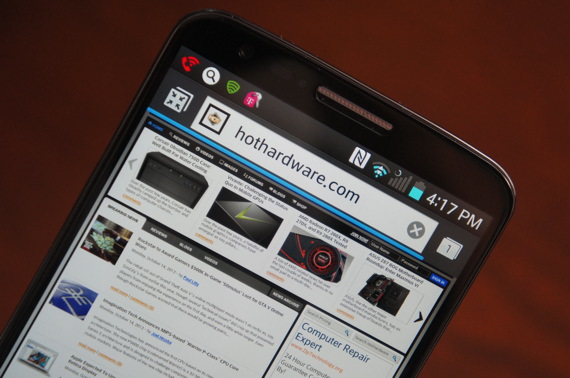LG G2 Smartphone Review: Snapdragon 800 Powered
Without question, Google Now is still the strongest selling point of Android over iOS, considering personal assistant features. If you're an avid user of Google services, and are willing to let Now pry into your digital life a bit, the suggestions, news, and information that it can offer up without you even asking is impressive and genuinely helpful. We've praised Google Now's ability to offer up flight information, directions for the best route home from work, scores from our favorite teams, and great eatery suggestions, and Now works splendidly on the G2. It's also wildly fast on the device, which in turn makes it even more functional.
For the most part, we aren't huge fans of LG's Android skin. The fonts look more stoic than the Roboto font used on Nexus products, and there just seems to be a general lack of polish in how icons are designed. It's possible that there's some subtle design preferences lost in translation between South Korea and North America, but it's just not as beautiful as vanilla Android. That said, those willing to take a slight performance hit can load up their own ROMs, launchers, skins, etc. One beauty of Android is that it's almost infinitely customizable.
All of that being said, there's no denying the speed here. Flipping between home panes is super quick. We found ourselves swiping between them just for fun, as watching the transitions take place is a (nerdy) sight to behold. This device runs Android like a champion. Lag is absolutely not a part of the equation on any level. If you must have instant gratification when using a smartphone OS, the G2 delivers.
We also want to point out one software tweak that's unique to the G2, but should absolutely, unequivocally be a part of every smartphone OS on the planet. There's a new double-tap feature which allows users to awaken their phone's display by just tapping twice on the screen. No reaching for the power button; just tap twice, and unlock your phone. Better still, another double-tap locks it. It sounds like a minor inclusion, and if you're looking at it purely from a coding perspective, it's probably quite small indeed. But in practice, it makes using the phone so much easier. Unlocking and locking the phone is so much more natural, and LG's engineers deserve a lot of credit for developing a simple, intuitive solution to this problem.
We also love the G2's pull-down notification window. Novice users may find themselves overwhelmed with options, but power users will appreciate what's here. You'll find quick toggles for nearly every major setting on the phone (and it's customizable, too), as well as a list of QSlide apps (apps that can run atop other apps in multi-tasking view), a brightness slider, a volume slider, your typical app notifications, and a trigger than launches the full Settings menu.
One final niggle: after using iOS for some time and growing used to our screen lighting up to showcase a notification, the G2's use of a nondescript blinking LED was quite underwhelming. There's no native way to make Android flash specific notifications on your locked, darkened screen. The apps available to do it are janky at best, leaving the experience less than desirable. iOS' drop-down notification center is pretty barren, but at least it can showcase notifications even when your screen is flipped off. We're hoping that Android adds something similar to what the Moto X offers, once Kit Kat races onto the scene in the coming months.














